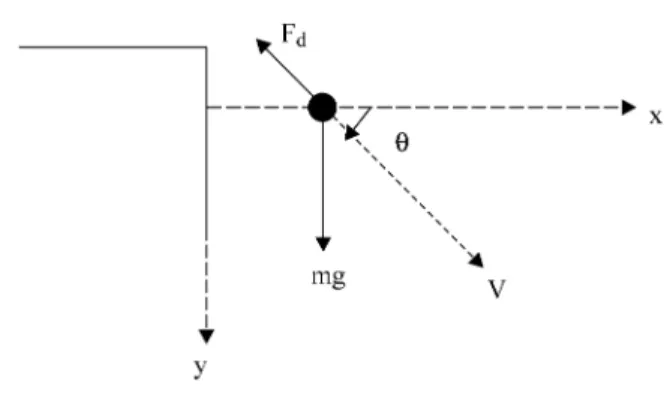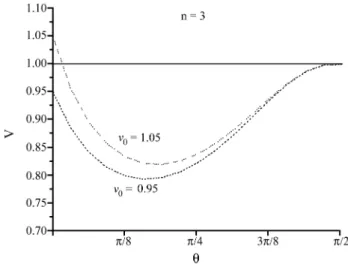Revista Brasileira de Ensino de F´ısica,v. 26, n. 2, p. 125 - 127, (2004) www.sbfisica.org.br
Minimum and terminal velocities in projectile motion
E.N. Miranda
1, S. Nikolskaya and R. Riba
1
Facultad de Ingenier´ıa, Universidad de Mendoza, Mendoza, Argentina
Recebido em 23/02/04; Aceito em 09/04
The motion of a projectile with horizontal initial velocityV0, moving under the action of the gravitational field and a drag force is studied analytically. As it is well known, the projectile reaches a terminal velocityVterm. There is a curious result
concerning the minimum speedVmin; it turns out that the minimum velocity is lower than the terminal one ifV0> Vtermand
is lower than the initial one ifV0 < Vterm. These results show that the velocity is not a monotonous function. If the initial
speed is not horizontal, there is an angle range where the velocity shows the same behavior mentioned previously. Out of that range, the velocity is a monotonous function. These results comes out from numerical simulations.
Keywords:projectile motion, drag force, Euler equation, terminal velocity.
O movimento de um proj´etil com velocidade horizontal inicialV0, movendo-se sob ac¸˜ao do campo gravitacional e de uma forc¸a de arrasto ´e estudado analiticamente. Como sabemos, o proj´etil alcanc¸a uma velocidade terminalVterm. Existe um
resultado curioso sobre a velocidade m´ınima Vmin; acontece que a velocidade m´ınima ´e menor que a velocidade terminal se
V0 > Vterme ´e menor do que a velocidade inicial seV0 < Vterm. Estes resultados mostram que a velocidade n˜ao ´e uma
func¸˜ao monotˆonica.
Palavras-chave:movimento de proj´etil, forc¸a de arrasto, equac¸˜ao de Euler, velocidade terminal.
In this article we deal with a simple problem, namely to de-termine the velocityV of a projectile launched with horizontal ve-locity in a medium with a drag force proportional to a power n of the body speed. The motivation to deal with such a problem is pedagogical. On one hand, it fits well in an intermediate course on classical mechanics [1] or even in a general physics course with calculus [2]. On the other hand, it could be use as a physical exam-ple of the Bernoulli equation in a mathematical physics course [3] or as an exercise in numerical analysis with an interesting physical interpretation.
It will be shown that the terminal velocityVtermis different
from the minimum oneVmin. Naively, one would have expected
that the minimum velocity is the terminal one, but it comes out that the projectile speed diminishes until it reaches a minimum and then it starts increasing. The terminal velocity is finally reached from below,i.e. from lower velocities. This means that the veloc-ity is not a monotonous function but it shows a minimum different from the initial and terminal velocities. This behavior is the same for any value of the powernin the drag force.
If the initial velocityV0 in not horizontal, the problem may be studied numerically. There is an angle range where the men-tioned behavior is found. Out of that range, the velocity becomes a monotonous function and the minimum speed is the initial one (if V0 < Vterm) or the terminal one (ifV0> Vterm)
Let us assume that a projectile of massmis launched
horizon-tally with an initial velocityV0from the top of a cliff -see Figure 1.
Figure 1 - This is the problem considered in the article: a projectile is launched from a cliff with an initial speedV0. It moves under the action of the gravitational forcemgand a drag forceFdthat is
proportional to a powernof the speed. It is convenient to choose the angleθas the independent variable.
It is subject to the action of a gravitational fieldgand of a drag forceFdwhich is proportional to a powernof the velocity. Ifθ
is the angle between the projectile velocity and the horizontal, the equations of motion are:
1Enviar correspondˆencia para E. N. Miranda. E-mail: emiranda@lab.cricyt.edu.ar.
126
Miranda
et al.mdVx
dt = −Fdcosθ
mdVy
dt = −Fdsinθ+mg
(1)
whereVx =V cosθ,Vy=VsinθandFd =kVn.The
propor-tionality constant in the drag force can be expressed in terms of the terminal velocityVterm.In the equilibrium condition,mg =
kVn
termandk=mg/Vtermn . It is convenient to use dimensionless
quantities; let us introduce:
vx=
Vx
Vterm
; vy=
Vy
Vterm
; τ = gt Vterm
; v=
p
V2
x +Vy2
Vterm
In this way, we may write the motion eqs. (1) as follow:
−dvx
dτ = v
n−1v
x
dvy
dτ = 1−v
n−1v
y
(2)
We will rewrite the previous equations to suppress the timeτfrom them: writevxandvyin terms ofvandθ;then multiply the
equa-tions bycosθ(orsinθ)and add (or subtract) them conveniently. In this way, we get a new system of equations:
dv
dτ = sinθ−v
n dθ dτ = cosθ v (3)
This new system allows us to eliminate the time τ, and get a Bernoulli equation [3]:
dv
dθ =vtanθ−v
n+1
secθ; θ < π/2 (4)
Notice that the above equation is not well define forθ=π/2. Our problem is to solve Eq. (4) which can be written as a linear differ-ential equation. For doing this, a change of variable is introduced: y=v−n.Thus, Eq. (4) becomes a linear one:
dy
dθ+nytanθ=nsecθ (5) Using standard techniques for solving linear differential equations, we finally get:
y= (cosθ)nn
Z θ
0
dΘ
(cos Θ)n+1 +y0(cosθ)
n (6)
The integral that appears above has an exact solution for any inte-ger value ofn[4]. Therefore, Eq. (6) is the solution we have been looking for; it gives us the velocity evolution for the whole trajec-tory in a closed form. We may write the explicit solution for some values ofn.Forn= 1, we get:
v= v0
cosθ+v0sinθ
(7)
In Figure 2 is shown a plot ofvas a function ofθ.It is clear that the terminal velocity is reached from below regardless the value of v0. The minimum velocity may be easily found, and it is:
vmin=
»
1 + 1 v2 0
–−1/2
<1, ∀v0
Figure 2 - The projectile velocityvas a function of the angleθ(in radians) for two different initial velocities: v0 = 2(upper curve) andv0 = 0.5(lower curve). In this case,n= 1. Notice that the terminal velocity (v= 1) is different from the minimum one. The projectile trajectory is bounded in the region0≤θ≤π/2.
This is a counter-intuitive result. One would have expected that the minimum velocity was1,i.e.the terminal velocity.
The same result is found for other powers ofn. Forn= 2, the velocity is given by:
1
v2 = sinθ+ cos 2 θln „˛ ˛ ˛ ˛
1 + sinθ cosθ ˛ ˛ ˛ ˛ « + 1 v2 0 cos2 θ (8)
and forn= 3, we get:
1
v3 = sinθ+ 2 sinθcos 2
θ+ 1 v3 0
cos3
θ (9)
Minimum and terminal velocities in projectile motion
127Figure 3 - The projectile velocityvin terms of the angleθfor initial velocitiesv0 = 1.05(upper curve) andv0 = 0.95(lower curve). The power in the drag force isn = 3. The difference between the minimum velocity and the terminal one is quite remarkable for these conditions.
We may wonder about what happens if the initial speed is not horizontal,i.e. ifθ0 6= 0. In this case, the ordinary differential equations displayed in (4) has been solved numerically. For that aim, a computer program was written that solves the system using a Runge-Kutta method of order fourth [5]. We have got several val-ues of the minimum speedvminas a function of the initial angle
θ0. See Figure 4 and 5 forn= 2andn= 3respectively. As can be seen from those Figures,vmin →1asθ0increases ifv0 >1, in other words, the minimum velocity is the terminal one for initial angles above a critical value (θ0 ∼50o). Also forv0 < 1there is a critical angle (θ0∼10o) above which the minimum velocity is the initial one. This means that the velocity is a monotonous function above those critical angles. Below the mentioned values, the velocity is non monotonous and the minimum velocity is lower than the initial one (ifv0 <1) or lower than the terminal one (if
v0>1).
Figure 4 - This figure shows the minimum velocity vmin of the projectile as a function of the initial angleθ0 (in degrees) of the speed with the horizontal. The drag force in proportional to the square of the velocity (n = 2). The upper (lower) curve is for an initial velocity greater (lower) than the terminal one: v0 = 2
(v0 = 0.5). Notice that below a certain angle (θ0 ∼ 50o for
v0 = 2andθ0 ∼10oforv0 = 0.5) the minimum speed is lower than the terminal one forv0 = 2, and lower than the initial one forv0 = 0.5. This shows that the velocity in not a monotonous function. Above those angles, the minimum speed is either the terminal one (v0= 2) or the initial one (v0= 0.5).
Figure 5: This figure is the same as Figure 4 but for a drag force that goes asFd ∼ V3. The minimum velocity shows the same
behavior as in Figure 4.
In summary, we have studied the trajectory of a projectile launched with horizontal velocity, and found a closed expression for the velocity as a function of the trajectory angle with the hori-zontal. It is surprising that the minimum velocity does not coincide with the terminal one. For any initial velocity, the projectile dimin-ishes its speed below the terminal one, and then it accelerates and reaches the terminal velocity. This behavior is qualitatively the same for any power-law drag force. If the initial speed is not hor-izontal, there is critical value for the initial angle below which the same behavior is observed. Above that critical angle, the velocity becomes a monotonous function.
Acknowledgments
One of the authors (ENM) thanks the National Research Council of Argentina (CONICET) for support.
References
[1] J.R. Marion, Classical Dynamics of Particles and Systems
(Academic Press, 1965).
[2] M. Alonso and E.J. Finn, Fundamental University Physics
(Addison-Wesley, 1968).
[3] S. Arfken,Mathematical Methods for Physicists(Academic Press, 1985).
[4] I.S. Gradshteyn and I.M. Ryzhik,Table of Integrals, Series and Products(Academic Press, 1980).

